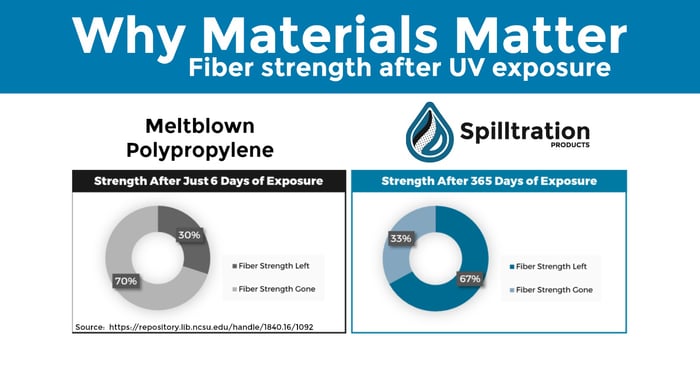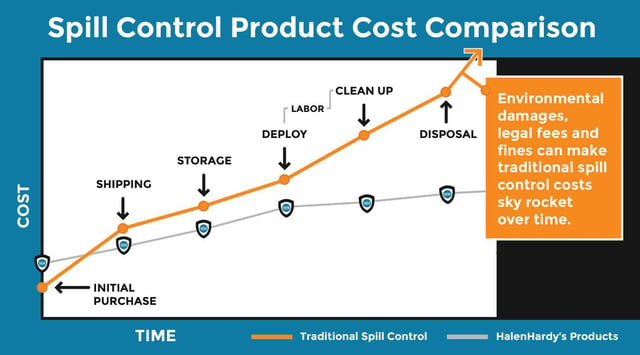When you work in the outdoors, you know that there aren’t many materials that can stand up to harsh elements like sun, wind and rain. And when it comes to spill containment or cleanup in the outdoors, traditional spill control products are no different.
 |
Have you seen this before? Old-fashioned white spill pads disintegrate in UV light. This degradation reduces the ability to control or contain spills. On top of that, clean up becomes difficult, if not impossible, when degraded materials scatter. |
Ultraviolet (UV) resistance for sorbents is a topic that’s always on the mind of environmental professionals that operate in outdoor industries. If you work in any of these industries you know what we’re talking about:
- Utilities transmission & distribution
- Heavy construction
- Transportation
- Oil and gas exploration
- Environmental engineering
They’ve watched their sorbent material waste away before their very eyes, time after time. Sadly, few even question it anymore. It is what it is. For the past 40 years, sorbents and spill control products have been made from the same old materials and perform the same old way. They certainly can’t stand up to wet conditions, much less the hot sun beating down on them. Environmental professionals know that ultraviolet degradation is a problem. What they don't understand is why degradation happens and what other solutions exists to avoid the constant waste.
To devise a solution, you first need to understand the problem. When you understand the potential UV degradation levels of different spill control materials—you can make better decisions about your specific needs. Eliminate the guesswork and choose the best material for your application.So here’s the lowdown on polypropylene and UV radiation
Plastic fibers are everywhere in today’s world. They’re in many of the products we use everyday from our sunglasses to our automobiles. But, no two plastics are the same. They all have different characteristics and uses. So, it’s important to consider the different plastics that exist.

Polypropylene is one of the most abundant plastic fibers that exist. Spill control materials are traditionally made up of these plastics — and most commonly, polypropylene is a key component. Polypropylene is often useful for high heat or chemical situations. At its most basic form, it’s a simple chain polymer. Due to its chemical structure, exposure to the sun’s UV radiation causes a photooxidative degradation (that’s when the bonds holding the polymers break down and weaken). Ultraviolet rays interact with the bonds and form free radicals and combine with oxygen and then discolor and crack. It deteriorates the mechanical properties of a material, essentially causing them to be useless. This polymer degradation changes the shape, color and tensile strength of the material.
This breakdown makes polypropylene less suitable for long-term outdoor sunlight exposure. It’s no wonder that you tend to see this type of plastic used for packaging, food containers and lab equipment and not necessarily for the roof of your shed.
» If you want to imagine UV degradation, think of your car. The paint on the outside has a protective polymer coating. Over time and exposure to the sun, the bonds of that coating will break down causing your paint to fade, become less glossy and crack. That’s why we clean and wax our vehicles to extend our paint life.
The process of UV degradation, or weathering, is one that costs companies big time.
Many of our customers work in mobile and remote locations and rely on spill pads to trap and contain oil until they can mobilize to the site to replace them. If you’re like most of our customers you’re used to using old fashioned white sorbents. And, you know they tend to give up long before the job is done, leaving you with an oily mess. Do you feel stuck with ineffective materials that don’t work? Then, it's time to choose spill control solutions that stand up to the rigors of the great outdoors. And that means choosing materials that can take the abuse of sun, wind and rain—without whining about it.
 |
Look familiar? UV light rapidly degrades traditional melt blown products, while Spilltration Husky products take a beating and keep on working. |
If your sorbents are ineffective in the outdoors, it’s time for new sorbents. These are just some of the ways that your current spill cleanup materials are costing you:
- Excessive waste
- Higher labor costs
- Higher materials costs
- HIgher disposal costs
- Harm to the environment
- Potential legal fees
- Big costs for spills that enter waterways
- Higher spill remediation costs
- Ineffective spill containment
- Increased storage cost for bulky, old fashioned sorbents
- Increased public scrutiny
What are The Seven Deadly Sins of Outdoor Oil Spill Control?
- Functionality:
Oil spill containment and cleanup solutions should work even in wet conditions. So, we designed our Spilltration® products to absorb oil and have the ability to filter clean, clear water through. - Space
Many operations simply don’t have enough space to store adequate spill control products. We help professionals take back their space. We created our Smoosh-Packing™ technology so you can fit 4x more product in the same space (for select products). - Speed
When a spill happens, you don’t have time to waste. Outdated spill materials are bulky and heavy. Spilltration® materials weigh 90% less than traditional sorbents and deploy up to 10x faster. - Waste
If your sorbents can’t stand up to the outdoors, then you are just wasting material over and over again. It’s bad for the environment and bad for your wallet. Our products are made to work in the applications that you need them to work in. - Ultraviolet Exposure
Most sorbents will disintegrate in a few short weeks when left out in the sun. They degrade into a mess of flakes that end up blowing all over the job site and any oil that was trapped in them washes out in the first rain. Our Spilltration® Husky fibers are more complex and use science to create intricate bonds that can stand up to ultraviolet radiation. - Unsustainability
Traditional spill control materials are good for just one use, which means a ton of waste in landfills. We care about our earth and decided to reduce our footprint with reusable sorbents. Simply wring out and reuse...up to 10x! And they last up to 5x longer in the outdoors and work to 100% efficiency. Most old fashioned sorbents only absorb about 30%. That’s just ridiculous. - Cost

Here’s the science behind our solution
When we researched how to create a spill control solution that actually worked, we knew we had to be innovative. We searched for material components and bonds that were different, ones that could create a preprogrammed lifespan that were dependable. The twiddly bits that make up HalenHardy’s® Spilltration® Husky fibers are more complex— utilizing ester properties between two binding groups. This configuration provides much greater UV resistance compared to the common polypropylene.
Spilltration® Husky Products are great for containing oil and fuel spills and can be combined with other Spilltration® products for added sorbency of these hydrocarbon sources.
- Hydraulic fluid
- Transformer oil
- Cutting fluids
- Diesel fuel
- Gasoline
- Lubricants
- Transmission fluids
- Fuel overfill
- Outdoor machinery
- Heavy equipment
- Leaky valves and pipes
We even offer Poly-backed Spilltration® Husky products which has a 4 mil poly backing that prevents oil or fuel leaks from penetrating the bottom of the absorbent material. This makes Husky Polyback perfect for combating long-term oil based leaks and spills, especially for remote work.
What this means for you.
If you utilize spill control products in the outdoors, you need a material that is suitable for environmental exposure. Due to their chemical properties, polypropylene based absorbents will break down under UV rays and are most likely not your best bet. Stop frustrating yourself with the ineffectiveness of old fashioned white spills pads, socks and booms. Stop wasting money on products that don’t work. If you’re looking for long-term outdoor spill control solutions, look no further than Spilltration® Husky. Wouldn’t you say it’s time for an upgrade?
Here's what one of our happy customers has to say:
» For years we have been frustrated with the ineffectiveness of white spill pads and socks for transformer oil leaks at our substations. They degrade to flakes in sunlight, blow all around the site and allow oil to wash out in rainy weather. White pads really make our cleanup job harder, not easier. Thankfully, Spilltration Husky products don’t degrade in sunlight and last for months and months.
–Environmental Manager, Major Electric Utility
If you have any questions on finding the right spill control products that meet your needs, just ask. Give us your crappiest job and we will help you find a better way.
Topics: Sorbents, Spill Cleanup

